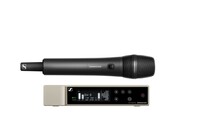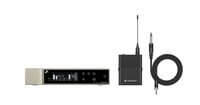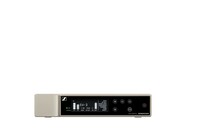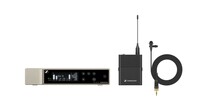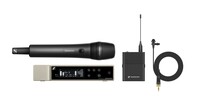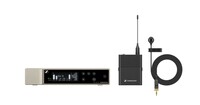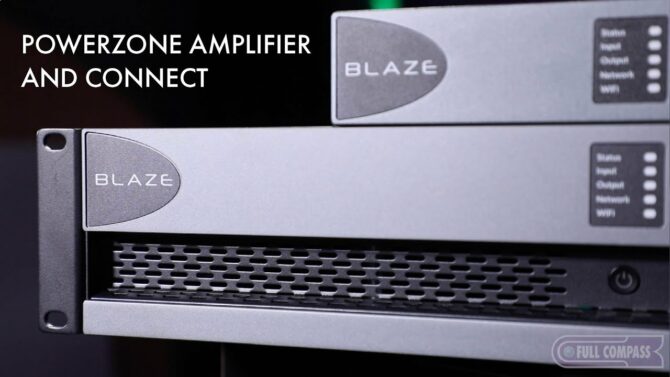When Sennheiser announces something new, I pay attention. My last Sennheiser review was the XSW-D digital Definition:
Definition:
A signal or data expressed as series of the digits 0 and 1, typically represented by values of a physical quantity such as voltage or magnetic polarization. wireless system, whose price point was designed to hit the masses. Still, it managed to embody the Sennheiser lineage, even in a wireless designed “for the rest of us.”
The EW-D (Evolution Wireless Digital) product family is a step up, yet the price remains reasonable (e.g., a complete handheld mic-based system is around $700). Unlike the 2.4 GHz Definition:
Definition:
Abbreviation for Gigahertz, which equals 1,000,000,000 cycles per second. XSW-D, we’re now in UHF Definition:
Definition:
(Ultra High Frequency) Radio-frequency band spanning 450 MHz to 952 MHz. Commonly used for wireless microphones and broadcast television. territory. EW-D’s downside is higher cost than 2.4 GHz-based systems, but in return Definition:
Definition:
A mixer input that receives the signal from an outside processor's output, whose input typically comes from a mixer's send or bus output. you have more bandwidth Definition:
Definition:
A range of frequencies that a device can generate, reproduce, or process. This usually implies little or no alteration within the range., significantly longer range, greater setup flexibility, and more robust operation for mission-critical applications.
For example, with 2.4 GHz, all systems need to self-negotiate—if you lose signal, it’s a problem. Environments that are loaded with cell Definition:
Definition:
1. An element of a battery that provides between 1.3 and 2.0 volts each (AAA, AA, C, and D Cells are popular). 2. In mobile communications, an area covered by one of many antennas. phones and wi-fi Definition:
Definition:
A wireless network protocol for device networking and internet access. Also spelled WiFi, wifi, or Wifi. complicate matters. With UHF, the EW-D can be set and locked on to a frequency Definition:
Definition:
A value, expressed in Hertz, that indicates how many cycles of a periodic signal occur in one second. . Also note that for UHF transmitters, the likelihood is greater that they’re not in the same range as other potential sources of interference. Furthermore, EW-D automates the process of scanning for free space, which is one of the reasons it’s easy to operate.
However, given that one of UHF’s main advantages is the ability to have multiple systems in play, then how to manage multiple systems becomes an issue—and perhaps this is where the EW-D system differentiates itself the most. The Smart Assist app for iOS Definition:
Definition:
Apple proprietary operating system, primarily for mobile devices (iPhone, iPad, iPod Touch, Apple Watch). Current Apple TVs run on tvOS, which is similar to, and based on, iOS. or Android communicates with a network of up to 16 system receivers over Bluetooth Low Energy Definition:
Definition:
(BLE) Short range low power Bluetooth standard, used for low power miniature devices and trackers.. The app can access all system settings, as well as do automated setup and remote Definition:
Definition:
A broadcast from the field, not from the studio. A Remote Control. monitoring.
Regarding audio characteristics, the dynamic range Definition:
Definition:
1. Range in dB between a device's noise floor and its maximum available headroom. 2. The difference between the maximum and minimum volume levels that occur in a musical performance. (in excess of 130 dB Definition:
Definition:
1. A deciBel is a logarithmic ratio between two quantities, and is a nonlinear measurement that mimics human perception. 2. A unit expressing sound levels relative to a nominal level just audible by the average human ear, and equal to 1/10th of a Bel.) is unique, and the sound performs the way you’d expect from a Sennheiser product.

Who Is It For?
Rather than thinking of the EW-D as a more upscale version of the XSW-D system, think of it as delivering UHF operation at a price point that’s competitive with lesser systems, and simplifies setup. As such, it’s intended for a wide range of applications: schools, houses of worship, bands, conferences and conventions, contractors, and so on.
For example, consider a panel discussion with 12 people, and four audience mics for Q&A. There are no issues dealing with 16 wireless systems. All those signals can go to the person running sound, who, thanks to the app, didn’t need to spend a lot of time on setup.
More specifically, EW-D systems are intended for easy setup by non-technical users. These days, users like businesses and houses of worship may not have a tech on call when needed, and musicians often have to do their own setup. Wireless without having to think about wireless is EW-D’s goal, hence the value of the Smart Assist app.
Setup

To give Sennheiser’s claims of easy setup the acid test, I wanted to see if I could get everything working by simply following the app’s step-by-step setup instructions, and then figuring out anything else by myself (like how to set the input gain Definition:
Definition:
The amount of amplification provided by an amplifier circuit, expressed in dB or numerically as in "3X" = "3 times". and output levels). I indeed got everything working without a problem, but I assumed I must have missed some fine points, so I eventually did dig around in the app’s manual. There really wasn’t anything significant I hadn’t already figured out.
You need to use a minimum of an iOS 12 or Android 8 device to run the Smart Assist app. My Android phone is stuck on 7, so I tested using the iOS version. When you open the app, first, there’s an introduction. The initial screen re-assures you that it’s a plug-and-play system, and you don’t need to be an expert (which turned out to be true). The next screen tells you not to worry about frequencies. Given that I have enough to worry about, that was cool. The next screen mentions the live Definition:
Definition:
Live broadcast of an event or program without substantial delay or editing. dashboard, and the final introduction screen reminds you that solutions and tutorials are available from within the app. Then it’s time to get started.
The first step is to add your receiver(s) to the app, which simply involves pressing a sync Definition:
Definition:
To make two or more pieces of equipment or signals synchronize with each other. button. Then you pair via Bluetooth Definition:
Definition:
A short distance (less than 33 feet) wireless data transfer standard. to your app, and once paired, you can name and color-code the receiver(s). (Unfortunately, I had only one receiver for testing, but adding more receivers just requires repeating this process.) After turning on all your receivers, you tell them to look for frequencies. Finally, you sync your transmitters to the receivers. I started with the handheld mic. The app told me to press the transmitter’s Sync button for 3 seconds, and after that, both the app and the receiver recognized that the EW-D mic was connected.
The next test was to set up the bodypack (which works with devices like guitar, line-level instruments, lavalier mics, and headset Definition:
Definition:
A headphone with boom microphone for intercom, communications, learning labs, gaming, or sportscasting. mics). But, I was informed there was an update for the receiver. So, that happened next. The standard firmware Definition:
Definition:
Software encoded into an integrated circuit, which unlike volatile memory, remains until altered and whose data persists after power cycles. update cautions apply—don’t touch anything after a firmware update starts. After about a minute, the receiver was updated…which was followed by additional updates for the handheld mic and bodypack. It all worked as expected.
Next I tried the bodypack with the devices that work with it. This simply required turning off the handheld mic, turning on the bodypack, plugging in the lavalier or headset mic…done. As to guitar, it also worked fine, even with passive Definition:
Definition:
An electrical device or circuit whose parts require no power (e.g., there are no transistors or tubes). pickups. Using guitar also made it easy to measure the latency Definition:
Definition:
The amount of delay a signal, data, sound, video, or control signal acquires within a device, system, or long-distance connection., which was about 1 ms from string pluck to audio output from the receiver—that’s pretty much the theoretical minimum, given that A/D/A conversion takes a finite amount of time, and there’s no way around that.
Going the Distance
With everything working, it was time to find out how far I could stray from the receiver. Like all wireless systems, the answer is “it depends.” (Note that all of these tests used only the two antenna Definition:
Definition:
A device for radiating or receiving electromagnetic signals. rods supplied with the receiver, not any of the accessory antennas described later.)
I tried the same “inside-a-house-through-as-many-walls-as-possible” test as the XSW-D—a distance of about 75 feet, from first floor to second floor, with multiple walls, ceiling, and a floor in between, along with various objects getting in the way as well. There were no dropouts, and I got the feeling I could have gone further if the house was bigger. I’m impressed when anything can cope with so many impediments between the receive and transmitter Definition:
Definition:
Any device that sends an electrical signal, typically radio waves or by wire..
Next, I checked how long the range was from my studio to outside, where the signal had to penetrate only one wall. I was able to go over a couple hundred feet without losing signal, so true line of sight could go further. In a situation where you’re on a stage and can see the front of house where the receiver resides, I’d venture that you could count on 250 feet, if not more. According to Sennheiser, under best-case conditions, the maximum distance the system can attain reliably is 330 feet.
Being digital, when I got out of range the signal just stopped, as if it had gone through a noise gate—you don’t get the artifacts Definition:
Definition:
Errors in digital conversion, recording, processing or transmission of audio and visual information caused by compression, quantization, jitter and/or packet loss. associated with analog Definition:
Definition:
A signal that is continuous in nature, as opposed to being defined as a series of discrete numbers (or elements) as found in digital signals; electrically "analogous" to an acoustical signal in the air. systems. As soon as I got back into range, the audio picked up again.
Incidentally, the EW-D uses Sennheiser’s equidistant tuning grid Definition:
Definition:
1. A structure of steel pipes or beams over the stage or audience to attach lighting, effects and sound equipment. 2. An internal component of a vacuum tube that controls the electron flow., and the system is resistant to the intermodulation distortion Definition:
Definition:
Undesirable distortion caused by the interaction of two or more signals that create harmonics not related to the input signals. associated with traditional systems. As a result, you can basically place the channels wherever you want. Frequencies can be packed closer together; not wasting RF Definition:
Definition:
(Radio Frequency) Electromagnetic radiation through the air, or electrical signals in cable. Typically, RF frequencies are above 100 kHz. spectrum leads to faster setup, and the ability to use more transmitters simultaneously, even in congested RF environments. Again, I didn’t have enough systems to check this out, but the concept is time-tested—I believe it was introduced in the Digital 9000 system, which has been around for almost a decade.
Meet the Family

In typical Sennheiser fashion, the EW-D family consists of multiple well-constructed elements, bundled into various systems (vocal, instrument, lavalier, etc.). However, it also works as an à la carte approach that simplifies customizing a system for certain applications, or expanding existing systems. Let’s meet the family, as represented by eight sets (bundles). All sets include the receiver, power supply Definition:
Definition:
A device (internal or external to another device) that provides power for active circuitry. Can be AC, DC or battery-powered., dual antennas, rubber feed, and rack mount Definition:
Definition:
19" wide equipment with mounting flanges for attaching to a 19" rack frame. hardware.
- Handheld set: Evolution handheld mic, e835 dynamic/cardioid capsule
 Definition:
Definition:
The portion of a microphone that converts acoustic energy to electrical, and may also contain additional mechanical and electrical elements especially if it is interchangeable., mic stand clamp - Instrument set: Bodypack and instrument cable
- Lavalier sets: Bodypack and choice of two clip-on microphones, ME 2 (omni-directional) or ME 4 (cardioid
 Definition:
Definition:
A microphone's heart-shaped directional pickup pattern.) - Combo set: ME 2 clip-on mic and Evolution handheld mic
- Headset set: Bodypack transmitter and ME 3 headset mic
- SK Base set: Bodypack transmitter
- SKM base set: Handheld mic without capsule
The base sets are the least expensive ($599 MAP), while the combo set is the most expensive, at $999 MAP. The receiver, bodypack, and mic without capsule are all $299.95 MAP.
And of course, there are accessories. The bodypack and handheld mic can run on two AA batteries (up to 8 hours of operation), or rechargeable battery Definition:
Definition:
An assembly of series-wired cells that provides higher voltages than individual cells. packs (up to 12 hours), which have associated charging stations. Compared to the XSW-D line, which had only rechargeable batteries, this is a major improvement. If you forget to charge the batteries, you don’t have to wait until they recharge—pop in some alkaline batteries, and keep on going.
If you want more reach, there’s an active antenna splitter, antenna booster, passive directional antenna, and a half-wave dipole Definition:
Definition:
1. A "T" shaped antenna with a figure-8 pattern. 2. A figure-8 speaker or microphone pattern. (that term alone brings back fond memories of my ham radio days). There are also cool little magnetic color indicators (“more level on purple, please”) and belt clips.
We Are the World
The AC adapters have six snap-in prongs for use with power connectors around the world, and the transmitters cover three frequency ranges: 470.2 - 526 MHz Definition:
Definition:
Abbreviation for Megahertz. 1,000,000 Hertz, or one million cycles per second., 520 - 576 MHz, and 552 - 607.8 MHz (named Q1-6, R1-6, and R4-9 respectively). When purchasing systems, you need to specify which frequency range you want. Granted, we don’t know what frequencies Martian space colonies will use, but for terrestrial applications, you’re pretty much covered.
Stepping Up
The EW-D series is a worthy step up from the XSW-D line. Yes, you’re paying more, but you get UHF operation, better spectrum use, simple setup, and perhaps most importantly, the Smart Assist app so that you can manage and set up relatively complex setups, even when the clock is against you. As I mentioned in the XSW-D review, it seemed like it was “the wireless for the rest of us.” The EW-D systems seem more like “the wireless for those who wanted more than the XSW-D, but also, something that’s easy to manage.” They won’t be disappointed.




